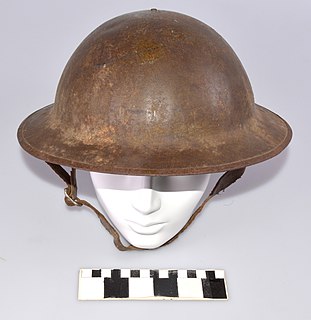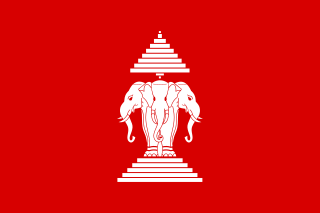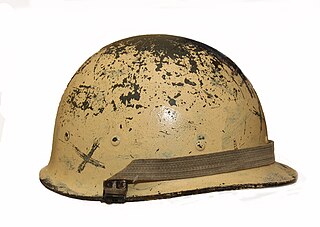
The Brodie helmet is a steel combat helmet designed and patented in London in 1915 by John Leopold Brodie. A modified form of it became the Helmet, Steel, Mark I in Britain and the M1917 Helmet in the US. Colloquially, it was called the shrapnel helmet, battle bowler, Tommy helmet, tin hat, and in the United States the doughboy helmet. It was also known as the dishpan hat, tin pan hat, washbasin and Kelly helmet. The German Army called it the Salatschüssel. The term Brodie is often misused. It is correctly applied only to the original 1915 Brodie's Steel Helmet, War Office Pattern.

The Stahlhelm is a German military steel combat helmet intended to provide protection against shrapnel and fragments of grenades. The term Stahlhelm refers both to a generic steel helmet and more specifically to the distinctive German military design.

The M1 helmet is a combat helmet that was used by the U.S. military from World War II until 1985, when it was succeeded by the PASGT helmet. The M1 helmet has become an icon of the US military, with its design inspiring other militaries around the world.

Combat boots are military boots designed to be worn by soldiers during combat or combat training, as opposed to during parades and other ceremonial duties. Modern combat boots are designed to provide a combination of grip, ankle stability, and foot protection suitable for a rugged environment. They are traditionally made of hardened and sometimes waterproofed leather. Today, many combat boots incorporate technologies originating in civilian hiking boots, such as Gore-Tex nylon side panels, which improve ventilation and comfort. They are also often specialized for certain climates and conditions, such as jungle boots, desert boots, and cold weather boots as well as specific uses, such as tanker boots and jump boots.

Jump boots are a type of combat boot designed for paratroopers featuring calf-length lacing and rigid toe caps. The style was developed in many countries simultaneously with the adoption of airborne infantry forces during World War II. Modern jump boots are earned in some countries and therefore have become a mark of achievement and distinction, mainly worn as dress and parade boots. The uppers are generally made of smooth black leather with toe-caps and heel counters that accept a high polish. It is also a paratrooper tradition to lace jump boots in a ladder or cobweb style which increases ankle support during a parachute jump.

The Special Naval Landing Forces were naval infantry units of the Imperial Japanese Navy (IJN) and were a part of the IJN Land Forces. They saw extensive service in the Second Sino-Japanese War and the Pacific theatre of World War II.

The peaked cap, peaked hat, service cap, barracks cover or combination cap is a form of headgear worn by the armed forces of many nations, as well as many uniformed civilian organisations such as law enforcement agencies and fire departments. It derives its name from its short visor, or peak, which was historically made of polished leather but increasingly is made of a cheaper synthetic substitute.

The Denison smock was a coverall jacket issued to Special Operations Executive (SOE) agents, the Parachute Regiment, the Glider Pilot Regiment, Air Landing Regiments, Air Observation Post Squadrons, Commando units, and other Commonwealth airborne units, to wear over their Battle Dress uniform during the Second World War. The garment was also issued as standard to the scout and sniper platoons of line infantry battalions.

The maroon beret in a military configuration has been an international symbol of airborne forces since the Second World War. It was first officially introduced by the British Army in 1942, at the direction of Major-General Frederick "Boy" Browning, commander of the British 1st Airborne Division. It was first worn by the Parachute Regiment in action in North Africa during November 1942.

The Mk III Helmet is a steel military combat helmet that was first developed for the British Army in 1941 by the Medical Research Council. First worn in combat by British and Canadian troops on D-Day, the Mk III and Mk IV were used alongside the Brodie helmet for the remainder of the Second World War. It is sometimes referred to as the "turtle" helmet by collectors, because of its vague resemblance to a turtle shell, as well as the 1944 pattern helmet.

The following is a general overview of the Heer main uniforms, used by the German army prior to and during World War II.

The M1C helmet was a variant of the U.S. Army's popular and iconic M1 helmet. Developed in World War II to replace the earlier M2 helmet, it was not made available until issued to paratroopers in January of 1945. It was different from the M2 in various ways, most importantly its bails. The M2 had fixed, spot welded "D" bales so named for their shape, similar to early M1s. It was found that when sat on or dropped, these bails would snap off. The solution was the implementation of the swivel bail, which could move around and so was less susceptible to breaking.

The Royal Lao Army, also designated by its anglicized title RLA, was the Land Component of the Royal Lao Armed Forces (FAR), the official military of the Kingdom of Laos during the North Vietnamese invasion of Laos and the Laotian Civil War between 1960 and 1975.

The Iraqi M80 Helmet is a military helmet made of compressed canvas used by the Iraqi Armed Forces from the early 1980s onwards. They were used in the Iran–Iraq War, the Persian Gulf War/Operation Desert Storm, and the 2003 Invasion of Iraq/Operation Iraqi Freedom. These helmets were originally manufactured and designed in South Korea by Hyundai Heavy Department or H.H. Didizian, both are South Korean companies, but in 1990 an Iraqi-made version appeared, which is usually fitted with a distinctive rubber rim. Both types of helmet are still in limited service with the Iraqi Security Forces but are being replaced by the American PASGT helmet.

The Luftwaffe was the air force of Nazi Germany prior to and during World War II. Luftwaffe styles of uniform and rank insignia had many unique features between 1935 and 1945. By Hitler's decision on February 26, 1935, the Luftwaffe was to be officially the third branch of the Wehrmacht as of March 1, 1935. The new Luftwaffe was faced with the problem of uniforms, as they wanted a uniform distinct from those of the other two branches of the Wehrmacht and also wanted a clear differentiation in dress of military and civilian flyers.
The OR-201, also designated Kasda OR-201 Model 76 or M-76 for short, is a combat helmet of Israeli origin. Developed in the 1970s, the OR-201 was one of the world's first ballistic helmets. It was subsequently exported on a large scale and has been used by many militaries worldwide.

The Royal Armoured Corps helmet is a combat helmet of British origin worn by Armoured Troops. As with the similarly shaped HSAT, it was initially manufactured by Briggs Motor Bodies at Dagenham. It was introduced in WW2 and was issued to commonwealth countries in the post-1945 era up to the Falklands War. The RAC helmets came with the same suspension and liner from the Brodie helmets and later the elasticated suspension and liner from the MkIII helmet. Many were converted to use as a Paratrooper Helmet.
The M76 Paratrooper helmet is a combat helmet of British origin issued to paratroopers and airborne forces of the British Army.

The SSK 90 helmet was a short-lived World War II Luftwaffe helmet. Manufactured by Siemens, the helmet consisted of an inner core of interlocking steel plates, a goatskin exterior, and an underside with foam rubber padding and a cloth lining; a prominent protrusion at the front helped to put on and take off the helmet quickly, and served as extra padding in case of a crash. The helmet had cutouts for earphones, and was designed to be worn over a cloth flight helmet outfitted with radio gear.

The Ssh-36 was a steel combat helmet developed and used by the Red Army. It was designed by Aleksandr A. Shvartz, and began production in 1936. Its large front rim and wide flares over the ears provided good protection for the wearer. The German M35, introduced a year before the Russian SSh-36, served as a model for the development of the SSh-36. The SSh-36 was also fitted with a comb on top, which allowed for ventilation. There were also apocryphal claims that the comb was designed to deflect saber blows.




















